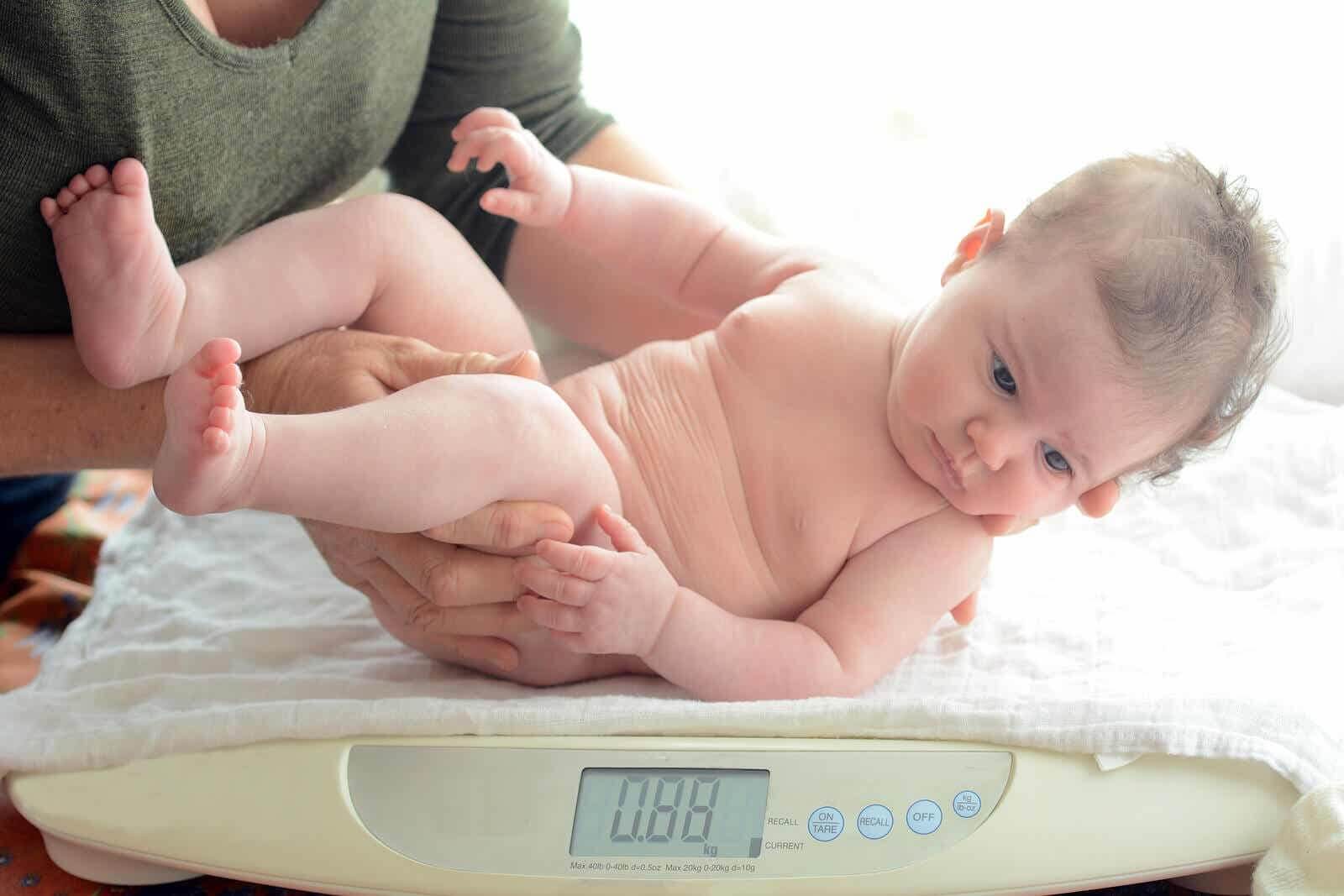Body Mass Index (BMI) In Children and Babies

While the body mass index (BMI) is data that can easily lead to incorrect interpretations in adults, it’s much more reliable in children. In fact, pediatricians use BMI to check the baby’s development, thus serving to detect deviations from the average.
First and foremost, it’s important to understand that babies undergo major changes during their first few months. Not only physiologically, but also in their structure. As such, it’s common for their weight to increase, as well as their height. But both variations must guard relative harmony to each other.

Calculating the body mass index
The first thing to know is the method we use in order to determine the body mass index. According to a study published in Obesity, we obtain the BMI by dividing the weight by the height in square meters. This gives us a value that allows for comparison between different babies, making it relatively easy to detect anomalies in growth.
However, it’s important not to take the data out of context. It’s essential to study the evolution of the baby’s body mass index, as well as to compare this data with existing data from other children.
To this end, there are a series of data tables that distribute the measurements between percentiles according to their frequency in the population. Depending on where each baby or child is placed in relation to their peers, a first diagnosis related to problems in development or body composition can be established.
It’s noteworthy that there are different tables depending on whether we’re talking about Caucasian, African, male or female children. Genetic differences also condition the speed of development and the morphology of the child.
Childhood obesity
One of the main uses of the body mass index is for detecting childhood obesity. This condition causes serious health problems in the medium term, as proven by a study published in Frontiers of Medicine.
This condition increases the risk of developing type 2 diabetes, cardiovascular problems and certain types of cancer. Therefore, it’s necessary to take care of lifestyle habits, including diet and physical activity. Even so, certain genetic variations can increase the ease of fat gain, making it difficult to manage body composition status.
Limitations of the body mass index
Even if it can be used in the context of clinical practice, the body mass index has certain limitations. The first of these is that it disregards the body compartments, and it analyzes the differences in weight and height as a whole.
It’s not possible to know whether the difference corresponds to an increase in bone mass, lean mass or fat mass. Increasing the percentage of one element isn’t the same as increasing the percentage of the other in terms of health.
For this reason, doctors frequently use other methods to analyze the child’s body composition and development. Among them we can mention bioelectrical impedance analysis, anthropometry by measuring skinfold thickness or, if necessary, magnetic resonance imaging.
With these mechanisms it’s possible to obtain a truer picture of reality and to analyze whether variations in weight are due to a dietary problem — fat gain— or to a normal developmental aspect —increase in muscle and bone size—.

However, it’s advisable for the professional to perform all these methods together. Otherwise the risk of error as well as the risk of misinterpretation increases.
Body mass index in children: a parameter with limitations
As you’ve seen, the body mass index can be useful for making certain comparisons, even if it has its limitations. Pediatricians use the BMI to analyze the baby’s development as well as to detect the risks associated with being overweight.
In any case, the correct interpretation of this measurement is key. For greater precision and in order to ensure greater reliability, other methods of measurement are necessary.
While the body mass index (BMI) is data that can easily lead to incorrect interpretations in adults, it’s much more reliable in children. In fact, pediatricians use BMI to check the baby’s development, thus serving to detect deviations from the average.
First and foremost, it’s important to understand that babies undergo major changes during their first few months. Not only physiologically, but also in their structure. As such, it’s common for their weight to increase, as well as their height. But both variations must guard relative harmony to each other.

Calculating the body mass index
The first thing to know is the method we use in order to determine the body mass index. According to a study published in Obesity, we obtain the BMI by dividing the weight by the height in square meters. This gives us a value that allows for comparison between different babies, making it relatively easy to detect anomalies in growth.
However, it’s important not to take the data out of context. It’s essential to study the evolution of the baby’s body mass index, as well as to compare this data with existing data from other children.
To this end, there are a series of data tables that distribute the measurements between percentiles according to their frequency in the population. Depending on where each baby or child is placed in relation to their peers, a first diagnosis related to problems in development or body composition can be established.
It’s noteworthy that there are different tables depending on whether we’re talking about Caucasian, African, male or female children. Genetic differences also condition the speed of development and the morphology of the child.
Childhood obesity
One of the main uses of the body mass index is for detecting childhood obesity. This condition causes serious health problems in the medium term, as proven by a study published in Frontiers of Medicine.
This condition increases the risk of developing type 2 diabetes, cardiovascular problems and certain types of cancer. Therefore, it’s necessary to take care of lifestyle habits, including diet and physical activity. Even so, certain genetic variations can increase the ease of fat gain, making it difficult to manage body composition status.
Limitations of the body mass index
Even if it can be used in the context of clinical practice, the body mass index has certain limitations. The first of these is that it disregards the body compartments, and it analyzes the differences in weight and height as a whole.
It’s not possible to know whether the difference corresponds to an increase in bone mass, lean mass or fat mass. Increasing the percentage of one element isn’t the same as increasing the percentage of the other in terms of health.
For this reason, doctors frequently use other methods to analyze the child’s body composition and development. Among them we can mention bioelectrical impedance analysis, anthropometry by measuring skinfold thickness or, if necessary, magnetic resonance imaging.
With these mechanisms it’s possible to obtain a truer picture of reality and to analyze whether variations in weight are due to a dietary problem — fat gain— or to a normal developmental aspect —increase in muscle and bone size—.

However, it’s advisable for the professional to perform all these methods together. Otherwise the risk of error as well as the risk of misinterpretation increases.
Body mass index in children: a parameter with limitations
As you’ve seen, the body mass index can be useful for making certain comparisons, even if it has its limitations. Pediatricians use the BMI to analyze the baby’s development as well as to detect the risks associated with being overweight.
In any case, the correct interpretation of this measurement is key. For greater precision and in order to ensure greater reliability, other methods of measurement are necessary.
All cited sources were thoroughly reviewed by our team to ensure their quality, reliability, currency, and validity. The bibliography of this article was considered reliable and of academic or scientific accuracy.
- Bichteler A, Gershoff ET. Identification of Children’s BMI Trajectories and Prediction from Weight Gain in Infancy. Obesity (Silver Spring). 2018 Jun;26(6):1050-1056. doi: 10.1002/oby.22177. Epub 2018 May 3. PMID: 29722476.
- Lee EY, Yoon KH. Epidemic obesity in children and adolescents: risk factors and prevention. Front Med. 2018 Dec;12(6):658-666. doi: 10.1007/s11684-018-0640-1. Epub 2018 Oct 2. PMID: 30280308.
This text is provided for informational purposes only and does not replace consultation with a professional. If in doubt, consult your specialist.








